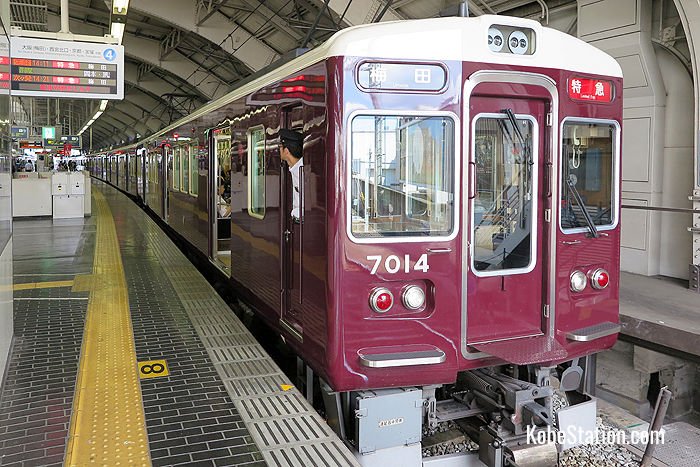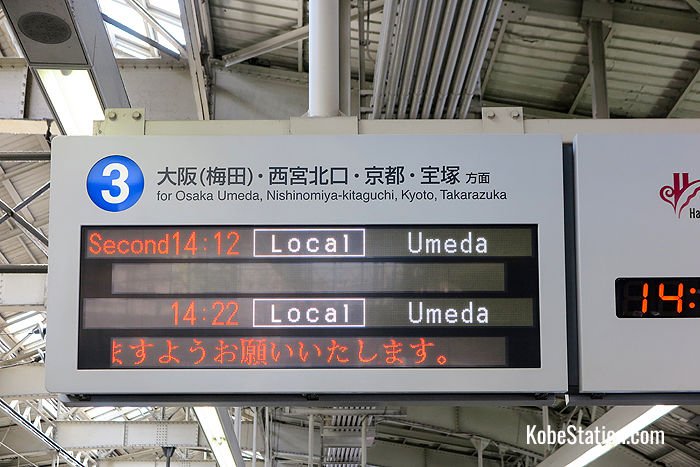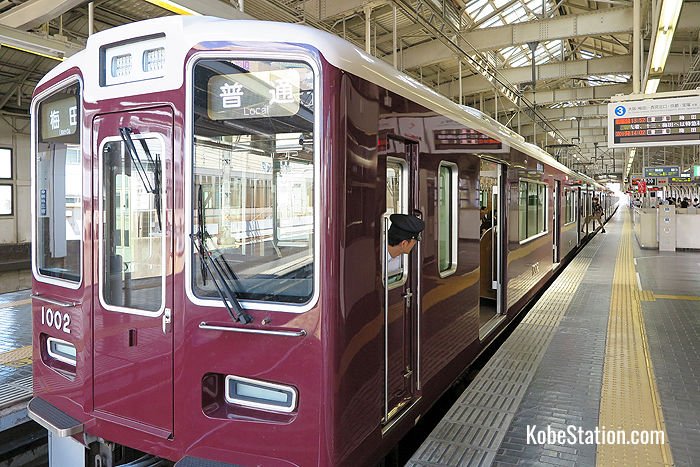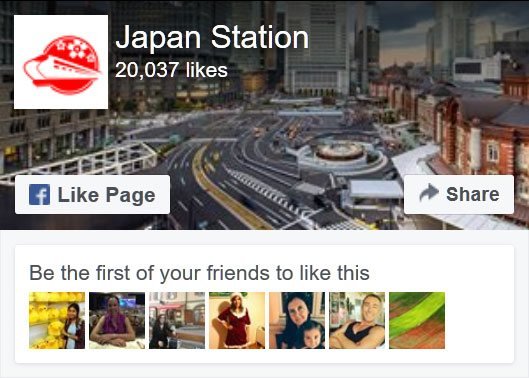The Hankyu Kobe Line is an important railway line connecting the cities of Kobe and Osaka. The line runs between Hankyu Kobe-Sannomiya Station in Kobe and Hankyu Osaka-Umeda Station in Osaka.

A Limited Express bound for Osaka at Hankyu Kobe-Sannomiya Station
The Hankyu Kobe Line is run by the private Hankyu Railway company, so it is not covered by the Japan Rail Pass. However, if you do not have a Japan Rail Pass the Hankyu Railway is a cheaper option. This line also provides easy access to Mount Rokko. At Hankyu Kobe-Sannomiya Station eastbound Hankyu Kobe Line services depart from Platforms 3 and 4. Westbound services continue on the Kobe Kosoku Line as far as Nishidai and then continue on the Sanyo Main Line as far as Himeji. These services can be boarded at Platforms 1 and 2.
Table of Contents

Departure information at Hankyu Kobe-Sannomiya Station
Key Destinations
There are 16 stations on the Hankyu Kobe Line.
Kobe-Sannomiya – Kasuganomichi – Oji-Koen – Rokko – Mikage – Okamoto – Ashiyagawa – Shukugawa – Nishinomiya-kitaguchi – Mukonoso – Tsukaguchi – Sonoda – Kanzakigawa – Juso – Nakatsu – Osaka-Umeda
The key destinations and transfer points are listed below with example train fares and journey times given from Kobe-Sannomiya Station.

A Local service at Hankyu Kobe-Sannomiya Station
Hankyu Kobe-Sannomiya Station
The Sannomiya district is a major entry point for the city of Kobe, because it is the location of several railway stations and bus terminals. This is also Kobe’s main area of business, shopping and entertainment. Kobe’s most popular shrine, the ancient Ikuta Jinja Shrine, is a 4 minute walk north of the Hankyu station. Kobe’s other main attractions are Mount Rokko, Chinatown (Nankinmachi), the seafront recreational area Meriken Park, the shopping and dining complex Kobe Harborland, and the Ijinkan, an area of foreign houses built in the 19th century.
Sannomiya is the location of three major stations which are all situated very close together. Hankyu-Kobe-Sannomiya Station serves eastbound Hankyu Kobe Line services and westbound Kosoku Kobe Line services. The other major stations are JR Sannomiya Station on the JR Kobe Line and Hanshin Kobe-Sannomiya Station on the Hanshin Main Line. Transfers can also be made in Sannomiya to the Seishin-Yamate Subway Line which has services bound for Shin-Kobe Station and to the Port Liner which serves Port Island and Kobe Airport.
Oji-Koen Station
Oji-Koen Station is convenient for Kobe city’s Oji Zoo where you can view a variety of animals including giant pandas, red pandas, big cats, elephants, and koalas. In one corner of the zoo’s grounds is a stately 19th century building which was formerly the residence of the British entrepreneur, E. H. Hunter. Hunter founded Osaka Iron Works which was the forerunner of the major engineering corporation Hitachi Zosen. The Old E. H. Hunter Residence is a nationally registered Important Cultural Property but is only occasionally opened to public viewing.
Train fare: 160 yen
Train time: 4 minutes by Local Train
Rokko Station
This station is convenient for the popular sightseeing and hiking area of Mount Rokko. From the station passengers can take a bus to the Rokko Cable Car which will take them up the mountain. At the top are various facilities including an observation deck with spectacular views, terrace dining, an alpine botanical garden and a music box museum. Rokko Hachiman Shrine is a large Shinto shrine dedicated to the god of war which was first established in 1026 and is just 2 minutes’ walk to the south of Rokko Station.
Train fare: 190 yen
Train time: 7 minutes by Local Train
Mikage Station
Mikage Station is a 4 minute walk from Yuzuruha Jinja Shrine. The shrine is said to date from the 3rd century when the legendary Empress Jingu prayed here for victory in battle. Today the shrine has more unusual sporting associations. A mythical three-legged crow called Yatagarasu is a shared symbol of this shrine and of the Japanese national soccer team, so the shrine has become very popular with soccer fans who pray here for victory before important matches. In more recent years the shrine has also become popular with fans of the figure skater Yuzuru Hanyu because his name and that of the shrine sound rather similar.
Kosetsu Art Museum is also just 6 minutes from the station and exhibits a fine collection of Japanese and Asian artworks such as Buddhist art, calligraphy, early modern paintings, lacquer ware, and weaponry. Hakutsuru Fine Art Museum is an 18 minute stroll to the north of Mikage Station through a leafy residential district called Sumiyoshiyamate. The museum houses a superb collection of ceramics, hanging scrolls, folding screens, ritual bronze vessels, antique paintings and other artworks from Japan and China.
Train fare: 190 yen
Train time: 12 minutes by Local Train
Okamoto Station
Okamoto Bairin Park is a park with 200 plum trees which is a 7 minute walk from Okamoto Station. The park is said to be the best place in Kobe to view plum blossom in February and early March.
Train fare: 190 yen
Train time: 7 minutes by Limited Express
Ashiyagawa Station
There are two museums close to Ashiyagawa Station. The Tawara Museum is a 3 minute walk to the south of the station and exhibits a rare collection of antique yatate which are small portable writing sets in ornamented cases which were used by samurai in the Edo era (1603 – 1868). The museum also exhibits other antique accessories as well as the beautifully decorated writing sets. The Tekisui Museum is a 9 minute walk to the north of the station and exhibits a collection of antique arts including ceramics, calligraphy, tea utensils, antique dolls, and karuta playing cards.
Train fare: 230 yen
Train time: 17 minutes by Local Train
Shukugawa Station
Transfer here to the Hankyu Koyo Line.
Train fare: 230 yen
Train time: 11 minutes by Limited Express
Nishinomiya-kitaguchi Station
Exit here for Hyogo Performing Arts Center, a live performance venue with a theater and two concert halls. The center hosts orchestral concerts, operas, ballets, chamber music recitals, jazz concerts, contemporary plays, musicals, and traditional Japanese performing arts. Hyogo Performing Arts Center is a 5 minute walk from the station.
Transfer here to the Hankyu Imazu Line.
Train fare: 270 yen
Train time: 14 minutes by Limited Express
Tsukaguchi Station
Transfer here to the Hankyu Itami Line.
Train fare: 280 yen
Train time: 31 minutes by Local Train
Juso Station
Transfer here to the Hankyu Kyoto Line or Hankyu Takarazuka Line.
Train fare: 320 yen
Train time: 24 minutes by Limited Express
Hankyu Osaka-Umeda Station
Osaka-Umeda Station is located in one of Osaka’s most popular shopping districts: Umeda. Popular attractions and shopping facilities in Umeda are the Umeda Sky Building, HEP Five, and Grand Front Osaka. Osaka’s major sightseeing attractions include Osaka Castle, the bright lights of the Dotonbori entertainment district, Tsutenkaku Tower in the colorful Shinsekai district, and the Universal Studios Japan (USJ) theme park.
Umeda is also a major transportation hub with several railway stations and a highway bus terminal. Transfers can be made at Osaka Station to the following JR train lines: the Osaka Loop Line, Kansai Airport Line, Yamatoji Line, Hanwa Line, Takarazuka Line, Kobe Line, and Kyoto Line. Transfers can also be made at nearby Osaka-Umeda Subway Station to the Midosuji Subway Line and at Hanshin Osaka-Umeda Station to the Hanshin Main Line.
Train fare: 320 yen
Train time: 28 minutes by Limited Express
Alternative Routes
In addition to the Hankyu Kobe Line there are two other competing rail lines that connect Kobe and Osaka: the JR Kobe Line and the Hanshin Main Line. All three of these lines have stations both in Sannomiya and Umeda that are within a short walking distance of each other. Let’s compare their services.
The JR Kobe Line provides the fastest service between JR Sannomiya Station and Osaka Station at 21 minutes by Special Rapid Train. It is also the most expensive service at 410 yen. However, this line is covered by the Japan Rail Pass. Because the Hankyu and Hanshin Railways are private railway companies you cannot use the Japan Rail Pass on their lines.
A Limited Express on the Hanshin Main Line will get you from Hanshin Kobe-Sannomiya Station to Hanshin Osaka-Umeda Station in approximately 30 minutes for 320 yen. This is cheaper than the JR service but pretty much the same as a Limited Express on the Hankyu Kobe Line which covers the same distance in roughly 29 minutes for 320 yen. There isn’t that much difference between the two private lines, but in Kobe the Hanshin station is slightly more convenient for areas to the south of Kobe-Sannomiya, and the Hankyu station is in a better position for areas to the north.
Discount Tickets
As the Hankyu Railway is a private company it is not covered by the Japan Rail Pass. However, a Hankyu Tourist Pass is available for 1 or 2-day travel. This might be worth your while if you are planning to use Hankyu Railways between Osaka, Kyoto and Kobe.
Visitors from overseas can also get a Kansai Thru Pass (also called the Surutto Kansai Pass) for two or three days. This covers not only the Hankyu Railway but many of the private railways, buses and subway systems in Osaka, Kyoto, Kobe, Nara and Shiga. This pass cannot be used on JR Railways however. Visit the Kansai Thru Pass website to find out more.
Hankyu Trains, Maps and Timetables
The Hankyu Railway is served by a variety of train types including Local trains, Semi-Express, Express, Rapid Express and Limited Express. Local trains are the slowest because they stop at all stations, while the Limited Express provides the fastest service, but may not stop at your station. It is important to get on the right train for your stop, and to know where to make appropriate transfers. The official Hankyu website has a clear and simple English language PDF guide to all the train types on the Kobe Line. This includes a color-coded route map showing exactly which stations each train stops at. For transfer information use an English language online route finder like the Japan Transit Planner or Hyperdia.
The Hankyu Railway website also has a bilingual map of the complete Hankyu Railway network. On this map the Kobe Line and its branch lines are colored blue. Timetables for this line can be downloaded from the individual webpages for Kobe-Sannomiya Station and Osaka-Umeda Station.
Article and original photos by Michael Lambe. All rights reserved.
